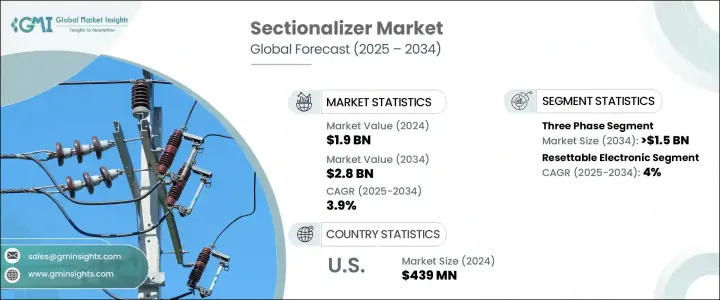
세계의 자동구간 개폐기 시장 규모는 2024년 19억 달러에 달했고, CAGR 3.9%로 성장해 2034년까지 28억 달러에 이를 것으로 예측됩니다.
이 꾸준한 확장의 배경은 신뢰성 있고 효율적인 배전 시스템에 대한 세계 수요 증가를 포함합니다. 급속한 도시화, 산업 성장, 디지털 기술의 등장이 세계 전력 인프라 투자를 촉진하고 있습니다. 원격 감시 및 감독 기능을 갖춘 스마트 자동구간 개폐기는 분산형 송전망에 대한 더 나은 고장 관리와 사전 제어를 가능하게 하기 위해 널리 채택되고 있습니다. 풍력과 태양광과 같은 신재생에너지원을 송전망에 통합하면 자동구간 개폐기가 효과적으로 제공하는 고도의 고장 격리장치와 지능형 스위칭장치에 대한 수요를 더욱 끌어올리고 있습니다.

시장개발은 선진국 및 신흥국을 불문하고 인프라 정비에 대한 투자가 증가하고 있는 것도 뒷받침하고 있습니다. 선진경제국가가 안전기준과 효율기준에 준거하기 위해 노후화한 송전망의 근대화에 주력하는 한편, 신흥국 시장에서는 특히 농촌와 원격지에서의 전기 프로젝트가 확대되고 있어 자동구간 개폐기 전개의 기회가 풍부하게 태어나고 있습니다. 송전망의 신뢰성을 높이고 다운타임을 최소화하는 것을 목적으로 하는 유리한 규제나 정부의 인센티브가 이러한 성장 요인에 박차를 가하고 있습니다.
| 시장 범위 | |
|---|---|
| 시작 연도 | 2024년 |
| 예측 연도 | 2025-2034년 |
| 시작 금액 | 19억 달러 |
| 예측 금액 | 28억 달러 |
| CAGR | 3.9% |
단상분야는 2034년까지 12억 달러에 달할 것으로 예상되고 있습니다. 소규모 커뮤니티 및 원격 지역에서 고장을 신속하게 격리하고 중단을 최소화하고 전력을 복구하기 위해 유틸리티 회사는 점점 단상 시퀀서에 의존하고 있습니다.
제어 부문에서는 재설정 가능한 전자 세분화기 부문이 2034년까지 연평균 복합 성장률(CAGR) 4%를 보일 것으로 예측됩니다. 이 세분화기는 최신 배전 시스템에서 신뢰성 향상, 자동화 기능 및 유연성이 탁월합니다. 개입 없이 일시적인 고장으로부터 서비스를 복구시키는 기능에 의해 정전 시간이 단축되고, 운용 효율이 향상됩니다.
미국의 자동구간 개폐기 2024년 시장 규모는 4억 3,900만 달러. 실질적인 경제생산량과 강력한 소비자 기반에 뒷받침된 세계 경제에서 이 나라의 중요한 역할이 이 시장의 성장을 지지하고 있습니다. 2024년 4분기 실질 GDP 성장률은 2.4%로 미국은 세계 금융시장에서 지배적 지위를 유지하고 있으며 이는 미국 상장주식이 세계 시가총액의 74%를 차지하고 있다는 점에서도 분명합니다.
자동구간 개폐기 업계에서 사업을 전개하고 있는 주요 기업은 Bevins, Eaton Corporation, Schneider Electric, G&W Electric, ABB Ltd., Inael, Tavrida Electric, Zhiyuan Power Technology Co., Ltd., Elektrolites, Hubbell Incorporated, Entec Electric & Ltd., Heag, Celsa, S&C Electric 회사가 있습니다. 각 회사는 시장에서의 지위를 강화하기 위해 스마트 원격 감시와 자동 고장 격리 기능을 갖춘 선진적인 자동구간 개폐기를 개발하고, 기술 혁신에 주력하고 있습니다. 기업은 연구개발에 투자하여 스마트 그리드와의 통합을 강화하고, SCADA나 IoT 시스템과의 호환성을 강조함으로써 예지보전과 운용 효율을 높였습니다.
The Global Sectionalizer Market was valued at USD 1.9 billion in 2024 and is estimated to grow at a CAGR of 3.9% to reach USD 2.8 billion by 2034. This steady expansion is driven by the increasing global demand for reliable and efficient power distribution systems. Rapid urbanization, industrial growth, and the rise of digital technologies are fueling investments in electricity infrastructure worldwide. Smart sectionalizers equipped with remote monitoring and supervisory capabilities are being widely adopted, as they enable better fault management and proactive control over distributed grids. The integration of renewable energy sources such as wind and solar into the power grid is further propelling demand for advanced fault isolation and intelligent switching devices, which sectionalizers effectively provide.

The market growth is also supported by rising investments in infrastructure upgrades across developed and developing countries. While developed economies focus on modernizing aging grid networks to comply with safety and efficiency standards, emerging markets are expanding electrification projects, especially in rural and remote areas, creating ample opportunities for sectionalizer deployment. Favorable regulations and government incentives aimed at boosting grid reliability and minimizing downtime are adding to these growth factors.
| Market Scope | |
|---|---|
| Start Year | 2024 |
| Forecast Year | 2025-2034 |
| Start Value | $1.9 Billion |
| Forecast Value | $2.8 Billion |
| CAGR | 3.9% |
The single-phase segment is expected to reach USD 1.2 billion by 2034, largely due to increased electrification in rural and residential sectors where single-phase systems dominate. Their cost-effectiveness and suitability for moderate power loads make them a preferred choice. Utilities increasingly rely on single-phase sectionalizers to quickly isolate faults and restore power with minimal interruption in smaller communities and remote locations.
From a control perspective, the resettable electronic sectionalizer segment is forecasted to grow at a CAGR of 4% by 2034. These sectionalizers are prized for their enhanced reliability, automation features, and flexibility within modern distribution systems. Microprocessor-based controls allow utilities to customize settings such as fault thresholds, time delays, and automatic resets. Their ability to restore service following temporary faults without human intervention reduces outage durations and boosts operational efficiency. The rising adoption of smart grid technologies drives this segment, as resettable electronic sectionalizers integrate seamlessly with SCADA and Distribution Automation (DA) systems.
U.S. Sectionalizer Market generated USD 439 million in 2024. The country's significant role in the global economy, backed by substantial economic output and a strong consumer base, supports this market's growth. With a real GDP growth of 2.4% in Q4 2024, the U.S. maintains its dominant position in global financial markets, evidenced by U.S.-listed equities accounting for 74% of the world's market capitalization.
Key companies operating in the Sectionalizer Industry include Bevins, Eaton Corporation, Schneider Electric, G&W Electric, ABB Ltd., Inael, Tavrida Electric, Zhiyuan Power Technology Co., Ltd., Elektrolites, Hubbell Incorporated, Entec Electric & Electronics Co. Ltd., Heag, Celsa, S&C Electric Company. To strengthen their market position, companies focus on innovation by developing advanced sectionalizers featuring smart, remote monitoring, and automated fault isolation. Strategic partnerships with utilities and technology providers help deliver customized solutions tailored to regional grid needs. Expanding manufacturing capabilities and supply chains ensure timely delivery and scalability. Firms invest in R&D to enhance sectionalizer integration with smart grids, emphasizing compatibility with SCADA and IoT systems for predictive maintenance and operational efficiency. Furthermore, targeted marketing and after-sales service programs improve customer retention and expand global reach, especially in emerging markets where electrification initiatives are accelerating.